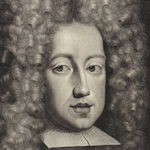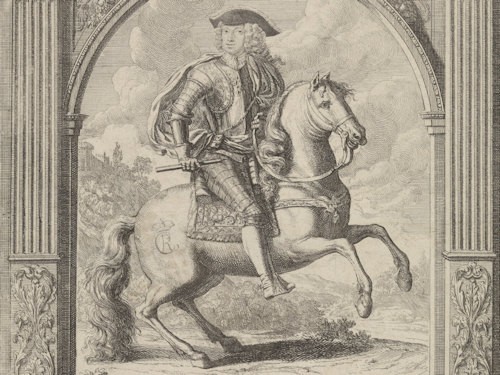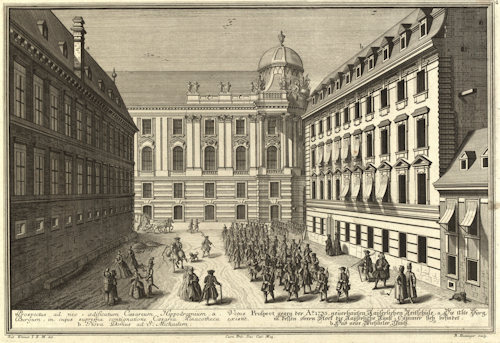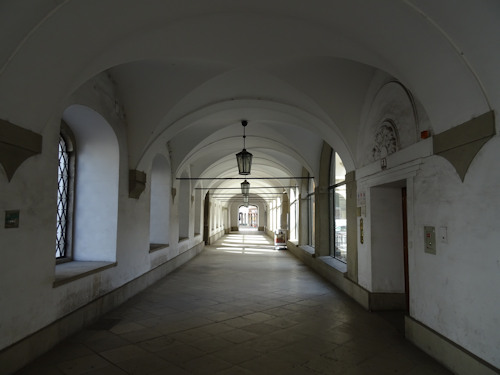
The history of the art of horse riding dates back almost 2,500 years to the time of the Greeks. The history of the Spanish Riding School in Vienna to the 16th century.
- Today’s winter riding arena dates back to the 1730s
- See also:
Greeks and Spaniards (?)

(The main arena of the Spanish Riding School today; photo taken with kind permission during a press tour)
The Greek philosopher Xenophon (431-354 BC) famously wrote two treatises on the subject of horse riding: On Horsemanship and The Cavalry General. And horsemanship continued to flourish under the Romans.
However, the so-called dark ages and the rather simple demands placed on medieval warhorses — presumably “run as fast as you can at the enemy” — did little for the development of classical horse-riding skills.

(Part of an equestrian portrait of Emperor Karl VI, who reigned when the new Winter Riding School formally opened. Image courtesy of the Rijksmuseum)
Fortunately, equestrianism experienced a resurgence in the mid-1500s, led in part by the need for more intelligent use of the horse in battle given that the riders now wielded firearms.
That resurgence eventually reached Vienna, where documents dating back to 1572 already refer to a wooden Spanish riding hall.
Why Spanish?
It seems Spanish horse breeds were best suited to the equestrian arts, and the Habsburg court used them exclusively for that purpose. The tradition continues today.
Not just any Spanish horse finds its way into the stables in Vienna, mind you…only the Lipizzaner, a breed which dates back to 1580 and Karl II Franz’s stud farm (see the article on the Lipizzaner stallions).
By the late 17th century, the court decided it needed a more permanent and sturdy riding environment than the existing wooden hall could provide.
As so often in days past, war interfered with imperial plans. So it was only in 1729 that work on today’s main arena for the Spanish Riding School (German: Spanische Hofreitschule) began within the buildings that form the Hofburg Palace complex.

(View of the new 1735 Imperial riding school; drawn by Salomon Kleiner, engraved by Johann Bernhard Hattinger, and published by Johann Andreas d. Ä. Pfeffel in 1737; Wien Museum Inv.-Nr. 105765/108; excerpt reproduced with permission under the terms of the CC0 licence)
The enclosed hall is largely unchanged since its official opening in 1735 under the aegis of Emperor Karl VI (whose portrait hangs at one end).
The architect behind the new design was one Johann Bernhard Fischer von Erlach, whose pen and ruler found further use in two other notable Baroque buildings from Karl VI’s reign: the Karlskirche church and the Prunksaal of the national library. Both buildings still belong to the very best of Vienna’s architectural jewels.

(The imperial carousel in the winter riding school on November 23rd, 1814; published by Artaria & Co. Verlag; Wien Museum Inv.-Nr. 23711/1, excerpt reproduced with permission under the terms of the CC0 licence)
White stone balustrades, galleries, and columns dominate the architecture of the riding arena (known as the winter riding school), with soft lighting from mammoth chandeliers.
The hall provides a majestic environment for the world’s oldest working riding school still practicing the classical art of renaissance dressage.
All tours, trainings and performances see you spend time inside, but the special architectural tour also takes you up through the ceiling and into the roof.

(View down the cloister running along outside the stables of the Spanish Riding School)
Although synonymous with the Spanish Riding School, this 18th-century arena building is actually just where performances and (public) trainings take place.
Other notable locations used by the institution include:
- The Renaissance Stallburg stables over the road, which are normally inaccessible to the public outside of a guided tour (which I can heartily recommend)
- The summer riding school with its large exercise area and horse walker (which you also see on the tour)

(The summer riding school; photo taken with kind permission during a press tour)
- The stud farm at Piber in the province of Styria, also open to the public
- A training centre in the country at Heldenberg in Lower Austria